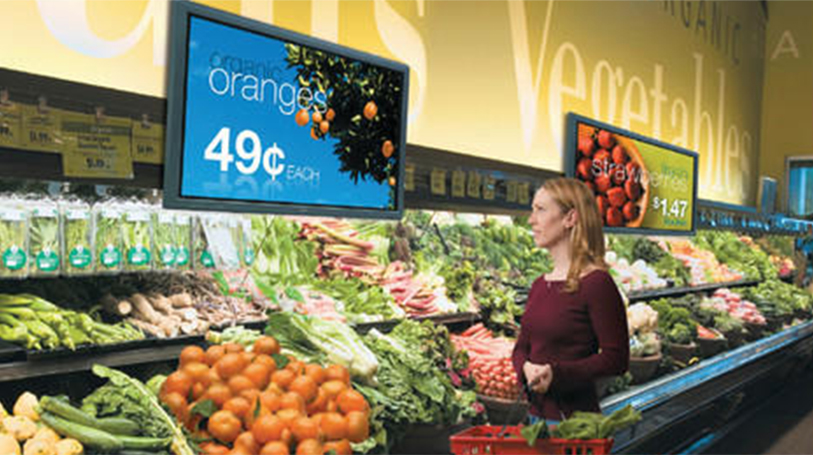How Grocers are Transforming Themselves Using SD-WAN, Digital Signage, and Employee Communications

Gone are the days of your mother sitting at the kitchen table with the Sunday paper, clipping coupons and making mile-long grocery lists, only to then spend several hours at potentially multiple stores to gather everything to feed the family.
Today, deals and coupons are available through our phones or through store loyalty programs–and emerging tech is being integrated into the brick-and-mortar store experience to enhance the shopping experience.
For grocers, this change in consumer behavior means a change is needed in technology. Say, SD-WAN to deliver bandwidth and traffic management needed to power guest Wi-Fi and support all those devices. Or, WiFi analytics to get better insight about how to server customers.
Changing customer expectations, too, are one of the main reasons digital signage solutions are gaining traction at a rapid pace.
Customers want constant connectivity, convenience and information at their fingertips. When those demands are not met, shopper loyalty and patronage erode, and eventually disappear. So, in what ways are grocers re-inventing themselves in the digital age to meet customer demands?
Here’s a short list to consider.
1. If you haven’t used self-checkout and newly available grocery delivery, you will be.
Since we no longer create mile-long lists to pick up the necessary items for the next two weeks, shoppers today would rather head to the store on their way home from work to pick up 3-5 things for that night’s meal and do so quickly. Therefore, grocers are finding that buyer purchasing data is a critical ingredient to condensing store formats to ensure that items are quickly and easily picked up followed up by a seamless, self-checkout process.
And as if that’s not fast enough, stores such as Amazon Go and apps such as Rosie allow users to store their credit card information, scan items as they shop, and ultimately leave the store within just a few minutes without ever speaking with a single person. With these things in mind, it is imperative that a grocer have the network infrastructure in place to ensure it can deliver.
2. The shopping experience needs to be AN experience.
Grocers need to look at things like tasting stations, standalone kiosks, and other digital signage solutions to showcase featured products – and then do so in a consumable fashion. For example, picture a digital sign above a meat and cheese counter that displays the current specials, but then offers a QR code or other method to a library of recipes with associated ingredients that could be used in preparing dinner that night. This offers clear digital signage benefits for grocers and shoppers alike, and is just one example. There are dozens of ways in which retailers are re-inventing the shopping experience to meet customer demands – therefore, grocers must keep a focus on emerging trends, because a good experience can go a long way to building or re-building customer loyalty and new customer acquisition.
3. The role of a grocery employee has changed.
Gone are the days of a traditional checker, bagger, stocker, and meat cutter. All of these rolls still exist, but they all have evolved to become more of a brand ambassador. Customers don’t care if you are behind the register or behind the meat counter. If they have a question, and the employee has an apron, it is expected that they know the answer and can deliver on the desired experience. Therefore, grocers have picked up on the notion that employees need to be trained across departments so that they can “triage” customer questions at least at a high level until someone more skilled can be found. But how does this cross-training happen while allowing them to learn as they work?
As of late, grocers have started to heavily invest in employee communication and training solutions that enable training to happen when and where it is most convenient rather than a training room – giving them the needed information to deliver a fabulous shopping experience – resulting in increased loyalty and increased sales. From a network perspective, grocers have also been heavily investing in enhancing guest Wi-Fi and network optimization to ensure the connection delivers everything the customer (and employee) expects and more.
4. Data is critical.
Integrity of customer data is essential to ensuring an even better, more optimized shopping experience. For example, if data suggests that a certain employee activity could be done faster or better, or a certain item should be stocked differently, grocers can rely on this data to make better informed, more timely decisions. Grocers should cease guessing and act on hard data that is surrendered at the will of the customer demanding convenience and a more streamlined shopping experience.
As stated above, this list only starts the areas where grocers are digitally transforming themselves to remain a viable competitor in the era of speed, convenience and agility. As grocers look to invest, it is imperative that these decisions be based on data – which then creates the “WHY.” Without the data, there can be no “WHY” and without the “WHY” the initiative will most likely run out of steam and the grocer will fail to meet the changing demands of today’s shoppers.